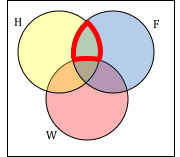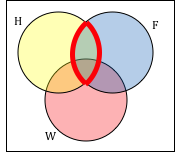It is natural for us to classify items into groups, or sets, and consider how those sets overlap with each other. We can use these sets understand relationships between groups, and to analyze survey data.
Introduction to Set Theory
An art collector might own a collection of paintings, while a music lover might keep a collection of CDs. Any collection of items can form a set.
Set
A set is a collection of distinct objects, called elements of the set
A set can be defined by describing the contents, or by listing the elements of the set, enclosed in curly brackets.
Example
Some examples of sets defined by describing the contents:
- The set of all even numbers
- The set of all books written about travel to Chile
Notation
Commonly, we will use a variable to represent a set, to make it easier to refer to that set later.
The symbol ∈ means “is an element of”.
A set that contains no elements, { }, is called the empty set and is notated ∅
Example
Let A = {1, 2, 3, 4}
To notate that 2 is element of the set, we’d write 2 ∈ A
Key Takeaways
A set simply specifies the contents; order is not important. The set represented by {1, 2, 3} is equivalent to the set {3, 1, 2}.
Subsets
Sometimes a collection might not contain all the elements of a set. For example, Chris owns three Madonna albums. While Chris’s collection is a set, we can also say it is a subset of the larger set of all Madonna albums.
Subset
A subset of a set A is another set that contains only elements from the set A, but may not contain all the elements of A.
If B is a subset of A, we write B ⊆ A
A proper subset is a subset that is not identical to the original set—it contains fewer elements.
If B is a proper subset of A, we write B ⊂ A
Example
Consider these three sets:
A = the set of all even numbers
B = {2, 4, 6}
C = {2, 3, 4, 6}
Here B ⊂ A since every element of B is also an even number, so is an element of A.
More formally, we could say B ⊂ A since if x ∈ B, then x ∈ A.
It is also true that B ⊂ C.
C is not a subset of A, since C contains an element, 3, that is not contained in A
Example
Suppose a set contains the plays “Much Ado About Nothing,” “MacBeth,” and “A Midsummer’s Night Dream.” What is a larger set this might be a subset of?
Try It Now
The set A = {1, 3, 5}. What is a larger set this might be a subset of?
Exercises
Given the set: A = {a, b, c, d}. List all of the subsets of A
Listing the sets is fine if you have only a few elements. However, if we were to list all of the subsets of a set containing many elements, it would be quite tedious. Instead, in the next example we will consider each element of the set separately.
Example
In the previous example, there are four elements. For the first element, a, either it’s in the set or it’s not. Thus there are 2 choices for that first element. Similarly, there are two choices for b—either it’s in the set or it’s not. Using just those two elements, list all the possible subsets of the set {a,b}
Now let’s include c, just for fun. List all the possible subsets of the new set {a,b,c}.
Again, either c is included or it isn’t, which gives us two choices. The outcomes are {}, {a}, {b}, {c}, {a,b}, {a,c}, {b,c}, {a,b,c}. Note that there are [latex]2^{3}=8[/latex] subsets.
If you include four elements, there would be [latex]2^{4}=16[/latex] subsets. 15 of those subsets are proper, 1 subset, namely {a,b,c,d}, is not.
In general, if you have n elements in your set, then there are [latex]2^{n}[/latex] subsets and [latex]2^{n}−1[/latex] proper subsets.
try it now
Union, Intersection, and Complement
Commonly, sets interact. For example, you and a new roommate decide to have a house party, and you both invite your circle of friends. At this party, two sets are being combined, though it might turn out that there are some friends that were in both sets.
Union, Intersection, and Complement
The union of two sets contains all the elements contained in either set (or both sets). The union is notated A ⋃ B. More formally, x ∊ A ⋃ B if x ∈ A or x ∈ B (or both)
The intersection of two sets contains only the elements that are in both sets. The intersection is notated A ⋂ B. More formally, x ∈ A ⋂ B if x ∈ A and x ∈ B.
The complement of a set A contains everything that is not in the set A. The complement is notated A’, or Ac, or sometimes ~A.
A universal set is a set that contains all the elements we are interested in. This would have to be defined by the context.
A complement is relative to the universal set, so Ac contains all the elements in the universal set that are not in A.
Example
- If we were discussing searching for books, the universal set might be all the books in the library.
- If we were grouping your Facebook friends, the universal set would be all your Facebook friends.
- If you were working with sets of numbers, the universal set might be all whole numbers, all integers, or all real numbers
Example
Suppose the universal set is U = all whole numbers from 1 to 9. If A = {1, 2, 4}, then Ac = {3, 5, 6, 7, 8, 9}.
Try It Now
Example
Consider the sets:
A = {red, green, blue}
B = {red, yellow, orange}
C = {red, orange, yellow, green, blue, purple}
Find the following:
- Find A ⋃ B
- Find A ⋂ B
- Find Ac⋂ C
Try It Now
Notice that in the example above, it would be hard to just ask for Ac, since everything from the color fuchsia to puppies and peanut butter are included in the complement of the set. For this reason, complements are usually only used with intersections, or when we have a universal set in place.
As we saw earlier with the expression Ac ⋂ C, set operations can be grouped together. Grouping symbols can be used like they are with arithmetic – to force an order of operations.
Example
Suppose H = {cat, dog, rabbit, mouse}, F = {dog, cow, duck, pig, rabbit}, and W = {duck, rabbit, deer, frog, mouse}
- Find (H ⋂ F) ⋃ W
- Find H ⋂ (F ⋃ W)
- Find (H ⋂ F)c ⋂ W
Venn Diagrams
To visualize the interaction of sets, John Venn in 1880 thought to use overlapping circles, building on a similar idea used by Leonhard Euler in the 18th century. These illustrations now called Venn Diagrams.
Venn Diagram
A Venn diagram represents each set by a circle, usually drawn inside of a containing box representing the universal set. Overlapping areas indicate elements common to both sets.
Basic Venn diagrams can illustrate the interaction of two or three sets.
Example
Create Venn diagrams to illustrate A ⋃ B, A ⋂ B, and Ac ⋂ B
A ⋃ B contains all elements in either set.
Example
Use a Venn diagram to illustrate (H ⋂ F)c ⋂ W
Example
Create an expression to represent the outlined part of the Venn diagram shown.

Try It Now
Create an expression to represent the outlined portion of the Venn diagram shown.

Cardinality
Often times we are interested in the number of items in a set or subset. This is called the cardinality of the set.
Cardinality
The number of elements in a set is the cardinality of that set.
The cardinality of the set A is often notated as |A| or n(A)
Exercises
Let A = {1, 2, 3, 4, 5, 6} and B = {2, 4, 6, 8}.
What is the cardinality of B? A ⋃ B, A ⋂ B?
try it now
Exercises
What is the cardinality of P = the set of English names for the months of the year?
Exercises
A survey asks 200 people “What beverage do you drink in the morning”, and offers choices:
- Tea only
- Coffee only
- Both coffee and tea
Suppose 20 report tea only, 80 report coffee only, 40 report both. How many people drink tea in the morning? How many people drink neither tea or coffee?
try it now
Example
A survey asks: Which online services have you used in the last month:
- Have used both
The results show 40% of those surveyed have used Twitter, 70% have used Facebook, and 20% have used both. How many people have used neither Twitter or Facebook?
Example
Now, to find how many people have not used either service, we’re looking for the cardinality of (F ⋃ T)c .
The previous example illustrated two important properties called cardinality properties:
Cardinality properties
- n(A ⋃ B) = n(A) + n(B) – n(A ⋂ B)
- n(Ac) = n(U) – n(A)
Notice that the first property can also be written in an equivalent form by solving for the cardinality of the intersection:
n(A ⋂ B) = n(A) + n(B) – n(A ⋃ B)
Example
Fifty students were surveyed, and asked if they were taking a social science (SS), humanities (HM) or a natural science (NS) course the next quarter.
21 were taking a SS course 26 were taking a HM course
19 were taking a NS course 9 were taking SS and HM
7 were taking SS and NS 10 were taking HM and NS
3 were taking all three 7 were taking none
How many students are only taking a SS course?
Try it now
One hundred fifty people were surveyed and asked if they believed in UFOs, ghosts, and Bigfoot.
43 believed in UFOs 44 believed in ghosts
25 believed in Bigfoot 10 believed in UFOs and ghosts
8 believed in ghosts and Bigfoot 5 believed in UFOs and Bigfoot
2 believed in all three
How many people surveyed believed in at least one of these things?
Candela Citations
- Mathematics for the Liberal Arts I. Provided by: Extended Learning Institute of Northern Virginia Community College. Located at: http://eli.nvcc.edu/. License: CC BY: Attribution
- Learning Objectives and Introduction. Provided by: Lumen Learning. License: CC BY: Attribution
- Revision and Adaptation. Provided by: Lumen Learning. License: CC BY: Attribution
- Question ID 132343. Provided by: Lumen Learning. License: CC BY: Attribution. License Terms: IMathAS Community License CC-BY + GPL
- Math in Society. Authored by: David Lippman. Located at: http://www.opentextbookstore.com/mathinsociety/. License: CC BY-SA: Attribution-ShareAlike
- Question ID 132343. Provided by: Lumen Learning. License: CC BY: Attribution
- Question ID 125855. Authored by: Bohart, Jenifer. License: CC BY: Attribution. License Terms: IMathAS Community License CC-BY + GPL
- Sets: drawing a Venn diagram. Authored by: David Lippman. Located at: https://youtu.be/CPeeOUldZ6M?list=PL7138FAEC01D6F3F3. License: CC BY: Attribution
- Sets: drawing a Venn diagram. Authored by: David Lippman. Located at: https://youtu.be/CPeeOUldZ6M. License: CC BY: Attribution
- Question ID 6699. Authored by: Morales, Lawrence. License: CC BY: Attribution. License Terms: IMathAS Community License CC-BY + GPL
- Sets: cardinality. Authored by: David Lippman. Located at: https://youtu.be/wErcETeKvrU. License: CC BY: Attribution
- Question ID 125872, 109842, 125878. Authored by: Bohart,Jenifer, mb Meacham,William. License: CC BY: Attribution. License Terms: IMathAS Community License CC-BY + GPL







